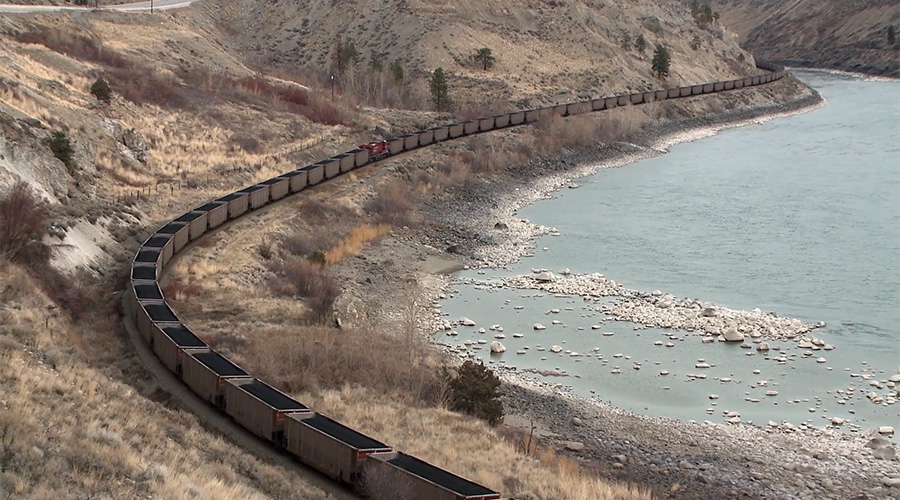Malenfant: CN is making the journey from PSR to DSR
6/8/2021
By Julie Sneider, Senior Associate Editor
Now in its second century of service as a transportation provider, CN has set out to be a global leader on the sustainability front — and it views its digital technology transformation as the key to achieving its economic, environmental, social and governance goals.
That’s the message that CN Executive Vice President and Chief Information and Technology Officer Dominique Malenfant delivered to attendees of Progressive Railroading’s May 26 rail summit titled “IT Advancements to Meet Organizational Strategy.”
Malenfant discussed how CN, the first Class I to implement precision scheduled railroading (PSR), is making the journey from “PSR to DSR,” or digital scheduled railroading.
“Fifteen years ago, when CN under Mr. [Hunter] Harrison introduced PSR, it disrupted the industry a little bit, and now most of the Class Is are adopting PSR and reaping the benefits of it,” Malenfant told the audience. “Now what CN wants to do is leverage technology and bring PSR to the next level: digital scheduled railroading. Our vision is to build a framework on which multiple digital templates will come into play that will cause us to raise the bar in the industry and bring a new disruptive model.”
CN’s PSR-to-DSR model aims to cover not only operational excellence but making improvements across the company’s sustainability goals that address topics such as improving customer service, the CN workplace, the environment and CN-served communities.
“What is the difference between PSR and CN’s vision for DSR? For us, the key element of PSR and how it will evolve into DSR is that we are moving from a cost-focused model to one that balances the needs of all our stakeholders,” said Malenfant.
That means shifting from a focus on cost reduction to one that balances growth. For safety, it means shifting from reducing accidents and injuries to eliminating them through digital products and practices that remove potential safety risks. For customers, it means closing the gap with the trucking industry by enabling shippers to track and trace rail shipments. For CN employees, it means shifting from a “people reduction focus” to “people enablement,” or leveraging digital technology so CN workers have the tools they need to perform tasks more efficiently and effectively.
“The world has changed dramatically over the last 15 years that ‘sustainability’ is no longer a fancy word, it’s something that must be incorporated into our operation and organization,” Malenfant said.
CN is “investing a lot” of money and energy into research, development and innovation to modernize all its IT infrastructure to make the railroad function better, he said. Malenfant and his team consider themselves the “digitalization enabler” of the company, as opposed to the “digitalization owner,” which is making a difference in how the company supports and adopts new technology. Among the technologies CN is exploring: internet of things (IoT), sensor data injection, mobility, analytics, rail automation and artificial intelligence.
“We’re trying to leverage all the technologies possible, including ones that are not typical to the rail industry,” he said.
Malenfant also presented several examples of DSR now underway at CN. They include:
• Autonomous track inspection program (ATIP). The Class I has deployed eight first-generation ATIP rail cars on its network and plans to add two this summer. The technology creates a profile of track under inspection and provides real-time geometric track parameters to find defects that, if not addressed, could interrupt normal railroad operations. By the end of 2020, the ATIP cars performed 375,000 miles of track inspection — and at one-tenth of the cost of manual track inspection. Currently, CN is developing the second-generation ATIP cars, which will have 3D LiDAR detection for right-of-way inspections.
• Automated train inspection. This sophisticated visualization system provides real-time inspection of trains as they pass through one of seven portals — five in Canada and two in the United States. Using ultra-high definition panoramic cameras, a full view of the train and the undercarriage is captured. The technology detects and locates defects that require maintenance, then generates work orders for repairs.
• Positive train control (PTC). Now in place, the U.S.-mandated safety technology was a “gigantic, somewhat painful and quite costly” project to implement, Malenfant acknowledged. But it is delivering the “huge safety benefits” it was designed to deliver — and is leading to side benefits, as well. For instance, CN is using the geospatial data network created for PTC to develop an electronic track authority verification (ETAV) application. Installed on a handheld device, the ETAV app provides a visual and audible alert when a maintenance-of-way crew member is in violation of track authority. CN expects the app to result in an 85% reduction in track authority violations, Malenfant said.
• API Marketplace. The application program interface enables CN customers and global supply-chain partners to track and trace their shipments. The APIs provide customers with critical information, such as the estimated time of arrival, shipment status and bill of lading (BOL).
In summary, Malenfant said technology is “clearly the driving force” of CN’s strategic agenda.
“I’m very proud of the IT team that I’m leading, and I strongly believe that we’re going to be very successful in deploying DSR,” he said.


